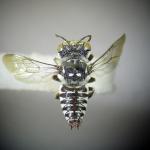A photographic test key by Rowson & Pavett (2008) is available via the BWARS website. Else and Edwards cover Coelioxys in their new book Handbook of the Bees of the British Isles, which is due for publication soon.
There is a single British record of Coelioxys afra from the New Forest, South Hants (1892). This record is thought to be a vagrant or introduction. The only other records are from Guernsey in the Channel Islands (Rowson & Pavett, 2008).
In Europe it is found from Spain to Lithuania and Italy to Belgium, it has also been recorded from the Greek mainland. It is mainly recorded from European countries with coastline. Further afield, it occurs as far as Oman (Else, in prep.).
In Britain, Shirt (1987) lists Coelioxys afra as Appendix (extinct) as there are no post-1900 records for the UK. The Channel Islands, for a number of reasons, are excluded from the geographical coverage of the British Red Data book.
Little is known about the preferred habitat of Coelioxys afra, however in Europe it is found in open, sandy habitats (Else, in prep.) which, since one of its suspected hosts is Megachile leachella Curtis (= dorsalis Pérez) (a sand dune species), is highly probable.
The New Forest record is dated as August 1892 (Else, in prep.). It is probably safe to assume that this bee has an approximately similar flight period to its known host (Megachile leachella), which flies from July to August, and therefore is likely to fly over a similar period and possibly slightly later than its host.
Coelioxys afra is a highly probable parasite of Megachile leachella based on the two being found in close proximity on Guernsey. In Germany, the Magachile is listed as being the host of Coelioxys afra (Westrich, 1989). The female of afra is the only species reported from Britain not to have a pointed sixth tergite and sternite. An egg is laid on the host’s food provision or next to the host’s egg (Else, in prep.). Generally, Coelioxys larvae kill, and in some species eat, the host egg immediately on hatching (Rowson & Pavett, 2008). Pupation occurs within a cocoon spun within the host cell where the larvae overwinters as a pre-pupa, prior to final pupation, presumably in spring of the following year.
There are no observations of flower visiting on the Channel Islands but in Germany Coelioxys afra is known to visit common bird’s-foot trefoil, white melilot, viper’s bugloss, wild marjoram, breckland thyme, Teucrium spp., greater knapweed and Irish fleabane (Westrich, 1989).
No data available.
2016


